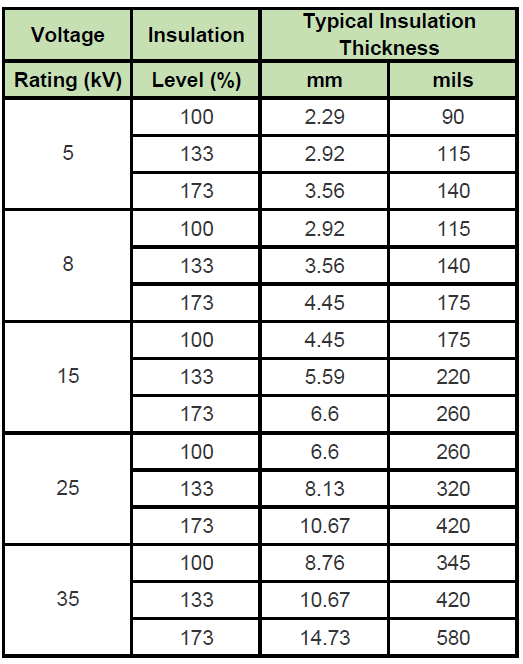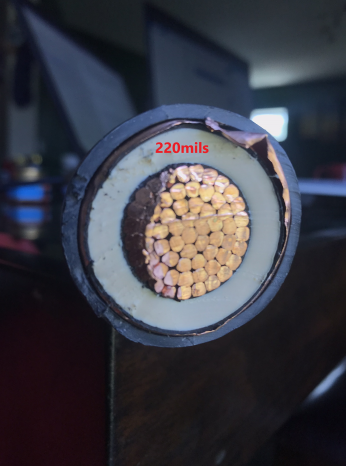Medium Voltage [MV] cable insulation is made of different variations of extruded solid or laminar (oil paper). Most common insulation in use today are:
- Cross-Linked Polyethylene (XLP)
- Ethylene Propylene Rubber (EPR)
- Polyethylene

Selection of a particular type of insulation material is dependent on the requirement for strength, flexibility, temperature etc. In addition to the type of insulation users are required to select the insulation category at which a particular cable will be applied. There are three percentage insulation levels:
- 100 percent level
- 133 percent level
- 173 percent level
What is meant by 100% insulation?
Cable insulation is designed for phase to neutral voltage. This means for a 15kV class cable, the insulation thickness will be based on 15kV/1.732= 8.66kV. For this particular cable the insulation thickness required to sustain phase-neutral voltage of 8.66kV is known as 100% insulation level.
100 percent insulation level: Cables in this category may be applied where phase to ground faults will be cleared as rapidly as possible, but definitely within one minute. For applications involving grounded source systems with ground fault protection 100 percent insulation is sufficient.
133 percent insulation level: This insulation level corresponds to cables that are applied in ungrounded systems. In an ungrounded system the phase to ground [or phase to neutral] voltage will rise to a value higher than normal phase to neutral voltage. Even a purely ungrounded system will have individual phases coupled to neutral/ground using cable stray capacitance meaning even in an ungrounded system the system is ‘effectively grounded’ using stray capacitance.
The value of voltage rise for during a phase-ground fault is determined by the relative ratio of zero to positive sequence impedance. Details of voltage rise on unfaulted phases during a ground fault is given in the article below:
Read: Voltage swell due to line-ground fault
133 percent insulated cables can be used where ground faults can be cleared within one hour and can be used on ungrounded circuits.
173 percent insulation level: When ground faults cannot be cleared within one-hour standards prescribe using 173 percent insulation. However, for most manufactures this is not a standard offering and customer will have to custom order or use a cable with higher voltage rating.
Read: Neutral inversion and Neutral Displacement
Insulation thickness for voltage ratings up to 46kV and various conductor sizes are given in NEMA, ICEA, UL and NFPA publications. Insulation thickness for each insulation level is similar across various industry standards. Typical insulation thickness for MV cables is given in table below.


Thicker insulation provide protection against temporary over voltages, transient voltages and reduces chance of failure from water tree growth. Thicker insulation has the downside of being more expensive and heavier. Many industrial users prefer 133 percent insulated cable for additional safety factor even if 100 percent rating is sufficient for the application. Electric utility companies tend to use 100 percent rate cables more than 133 percent rated cables possibly due to the fact that most utility systems are solidly grounded with good ground fault protection in addition to the cost savings gained by using 100 percent insulated cable.
Read: Medium Voltage cable construction
Summary
100% Insulation: Applications in which ground fault will be cleared in less than 1 minute.
133% Insulation: Applications in which ground fault will be cleared in less than 1 hour.
173% Insulation: Applications in which ground fault clearing time is infinite.
